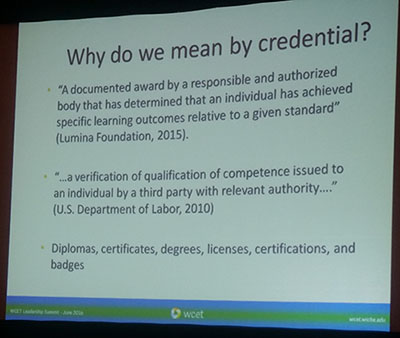21st Century Credentials: Telling the Story of the Whole Student
Published by: WCET | 6/23/2016
Tags: Access, Competency-based Education, Credentials, WCET, WCET Summit, Workforce/Employment
Published by: WCET | 6/23/2016
Tags: Access, Competency-based Education, Credentials, WCET, WCET Summit, Workforce/Employment
 Earlier this month WCET’ers gathered in Salt Lake City to have frank discussions and hear from leading experts in the somewhat nebulous construct of 21st Century Credentials. There is no way I can replicate the conversations held, the discussions, the debate in a blog post. But I can distill some of the themes and learning I walked away with and point you to the resources from the 2016 WCET Leadership Summit.
Earlier this month WCET’ers gathered in Salt Lake City to have frank discussions and hear from leading experts in the somewhat nebulous construct of 21st Century Credentials. There is no way I can replicate the conversations held, the discussions, the debate in a blog post. But I can distill some of the themes and learning I walked away with and point you to the resources from the 2016 WCET Leadership Summit.
Higher Ed Facing a “Trust Bust”
In our first plenary of the day, Mary Alice McCarthy of the New America Foundation confessed if you’d asked 5 years ago, she never would have guessed today’s conversation would be focused on credentials – I beg to say not many, if any, of us did. Sure, efforts like the Degree Qualifications Profile were underway five years ago, and Mozilla had started the Open Badges movement, and Sebastian Thrun was calling for the end of higher education as we know it through MOOCs. All of these conversations danced with the idea of alternative credentials and defining what a degree really means. They brought us to the place we are today, talking about credentials, how they relate to curriculum and enrollment and employment.
Ryan Craig, managing partner of University Ventures, started with two salient points about why we in higher education are having this conversation exploring credentials.
We are facing, as Craig termed it, a “trust bust” – both from the employer community and our learners. They no longer accept “trust us” with regard to our faculty’s ability to teach well or the skills contained within a degree. Jeff King, executive director, Center for Excellence in Transformative Learning, University of Central Oklahoma shared that the academic record of the future needs to show what students can do – transcripts are too opaque and are no longer being used by businesses. Hiring managers are using applicant tracking systems with sophisticated algorithms to filter resumes by keywords and then doing their own testing of prospective hires rather than trusting their credentials.
This all adds up to a loud call, a wake up call, if you will to the higher education community to drastically rethink how we demonstrate student learning and credential achievement. It was noted that grades are a proxy not necessarily indicative of what a student knows because they can be effected or skewed by poor assessments and failure of work ethic (i.e. an A paper might get a C because it was 3 days late). This circles back to being able to show what a student can do – to providing work samples, the authentic assessments that underlie credentials, not just grades.
Tell the Story of the Whole Student
Throughout the next day, the theme came up over and over again of what I’ve termed ‘telling the story of the whole student.’ Tactically we talked about extended transcripts and portfolios, competencies with rich, authentic assessments that produce work students can showcase when they go out onto the job market. We talked about being inclusive of the learning that occurs in college outside of the classroom through work experiences, campus leadership experiences, and extracurricular adventures. We even discussed how internships and other experiences not sanctioned through the institution but verified by an employer or other certifying entity might be included in the students learning record. Moving forward it will no longer be suitable to our students or their employers to simply provide that they got a A in English 101 – they’ll want to know why, how and what evidence there is of the learning and the skills developed. It will take radical shifts in all of our systems – the alphabet soup of linked (or sometimes not) software that we use to track students fiscally, academically, and out into their time as alumni. And it will take collaboration – both internally within institutions and externally with employers and solution providers to make it work.
Empower Students in Their Own Learning Journey
It’s one thing to showcase students work through the next generation of learning record, but the added layer of complexity is helping our students understand why they are learning what they are learning and then be able to be self-advocates on the job market, using their work samples to illustrate what they know and can do. Two e-portfolio companies we had at the Summit Portfolium and Foliotek, both grew out of a pain-point for their founders. For Chris Miller, CEO of Foliotek, it was watching his newly graduated daughter struggle to showcase the knowledge and skills she developed when she hit the job market – leading a caring dad to attack it, ‘there’s got to be a better way.’ Similarly, Adam Markowitz, Founder and CEO of Portfolium, was literally a rocket scientist, his lifelong dream, who left in order to launch a marketplace to help students showcase the skills and knowledge they gained at the university to potential employers.
 Portfolios are one way to help students explicate what they know and can do to employers. Another way, discussed at the Summit and through the many other connected credentials discussions with Lumina Foundation, Corporation for a Skilled Workforce, IMS Global, and the American Council on Education, is to clearly delineate the competencies associate with the work students do in college. It was suggested in many ways throughout the two days, that institutions who are not working with employers to define the competencies they need in graduates, will be left behind. And that graduates who do not have a clear understanding of their competencies and the work samples that support them will then suffer on the job market as employers turn to competency hiring rather than depending on the proxy of a college degree.
Portfolios are one way to help students explicate what they know and can do to employers. Another way, discussed at the Summit and through the many other connected credentials discussions with Lumina Foundation, Corporation for a Skilled Workforce, IMS Global, and the American Council on Education, is to clearly delineate the competencies associate with the work students do in college. It was suggested in many ways throughout the two days, that institutions who are not working with employers to define the competencies they need in graduates, will be left behind. And that graduates who do not have a clear understanding of their competencies and the work samples that support them will then suffer on the job market as employers turn to competency hiring rather than depending on the proxy of a college degree.
Again, this is not an easy task – there is no silver bullet. No one thing that will magically make competencies apparent and explicable by students. No one thing that will integrate all institutional systems to support next generation learning records. No one thing that will satisfy employers that your students have the knowledge, skills and work ethic they need to succeed. But it will take one thing – collaboration – within and external to the institution. Opening a multi-modal communication channel between and among internal and external stakeholders is the first step in making these changes.
WCET is The Place
Our Thursday morning moderator, Nick White, WCET Steering Committee chair and director of competency-based learning, Capella University told the story of the last time he was in Salt Lake City with his family and his then 3 and 5 year old daughters were into both make believe and chores. So, he took them to a park in Salt Lake City called “This is the Place Park” which holds significance for the Mormon church as the very place Salt Lake was chosen for their headquarters. They had the time of their year beating the dust out of rugs. Nick then, far more artfully than I am here, tied it back to being in a room full of like minds. That WCET is The Place. Many of us may have a hard time explaining to our friends, to people outside of our area of expertise, what the heck it is we do. But here, at WCET and specifically at this Summit, we are among colleagues, where we can think bigger and can meet new people who share our passions, vision, and mission.
I encourage you to watch the videos, check out the slides, the infographics, the amazing twitter backchannel, and other resources developed in support of the WCET Summit. I invite you to join the conversation at our 28th WCET Annual Meeting (registration is open, the full program will be live soon). Engage with your colleagues through the WCET member email list. Because WCET truly is the place where ideas take form and colleagues share pragmatic solutions.
 Cali Morrison
Cali Morrison
Communications Manager
WCET
@calimorrison
1 reply on “21st Century Credentials: Telling the Story of the Whole Student”
Thanks for this overview, Cali! Very valuable for those of us not able to attend.